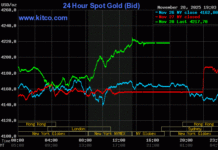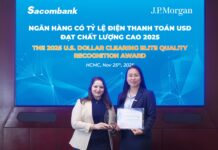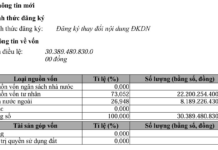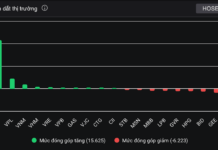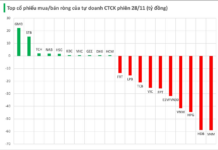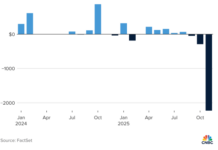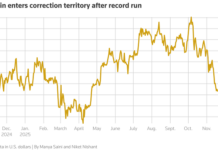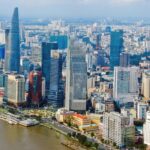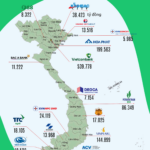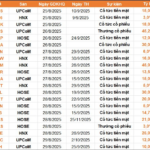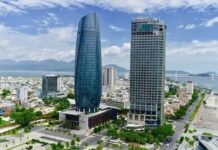At the Fitch on Vietnam 2025 event on August 28, Vietnam’s economic landscape was painted with diverse colors. On the one hand, there was solid growth, stable FDI, and healthy public finances; on the other, challenges arose from concentrated trade structures, inadequate infrastructure, and signs of credit overload.
Ms. Nguyen Thuy Hanh, CEO of Standard Chartered Vietnam, acknowledged the pressure from the US imposing a 20% tariff on goods from Vietnam, but believed it wasn’t insurmountable. Many businesses quickly negotiated with partners to share the burden, resulting in a lower actual increase of 2-10%.
“Our clients renegotiated with US partners, so the actual impact wasn’t 20%, but around 10% in some cases, and even as low as 2% in others,” said Ms. Hanh. This adaptability of Vietnamese businesses, honed through shocks from the pandemic to global trade fluctuations, was commendable. However, she emphasized the core issue of dual dependence: heavy reliance on exports to the US while nearly half of raw materials are still imported from China. Despite efforts to diversify markets over the past three years, results have been limited.
According to experts, the growth model relying on FDI and exports will persist, but there’s a need to simultaneously boost domestic investment and domestic consumption to reduce external impacts. Logistics also contributes to higher production costs compared to many regional countries. Therefore, investing in infrastructure and encouraging the private sector to take a leading role are considered keys to enhancing competitiveness.

Ms. Nguyen Thuy Hanh suggested promoting domestic investment and domestic consumption – Photo: Tu Kinh
|
Sharing this view, Mr. Tran Phuong, Deputy General Director of BIDV, stated that Vietnam still imports over 47% of raw materials from China. He pointed out that without developing processing centers and supporting industries, production costs would continue to rise. To reduce this dependence, Vietnam needs to simultaneously promote supporting industries, build domestic production capacity, and expand domestic consumption to create more sustainable growth momentum.
Mr. Phuong appreciated the institutional reform efforts, especially the reduction of 30% of procedures, 30% of compliance costs, and the elimination of 30% of overlapping regulations. This provided an important impetus for the private sector to thrive. However, institutional reform needs to go hand in hand with financial reform.
In the context of rapid credit growth, he emphasized the imperative of controlling loan quality. If credit growth exceeds 12% per year without additional capital, banks will struggle to maintain capital safety.
“Credit growth must be controlled and shouldn’t return to the high growth rate of 18% eight years ago. It’s crucial to ensure loan quality, as maintaining a bad debt coverage ratio below 100% could pose risks to the system,” the expert stressed. He affirmed that internal supervision, tight risk management, and leveraging data from the National Credit Information Center (CIC) are vital for maintaining bank safety and system stability.
Fitch forecasts GDP growth for the year to be below 6%
From an international perspective, Mr. George Xu, Director of Fitch Ratings for the Asia-Pacific region, shared that Vietnam maintained its BB+ credit rating with a stable outlook, thanks to its superior mid-term growth potential compared to many countries in the same group. In the first half of 2025, GDP grew by 7.5%, higher than the 7.1% in the previous year, driven by strong exports and public investment disbursement.
FDI was also a bright spot, with $13 billion disbursed in the first seven months and $10 billion in new registrations, mainly in manufacturing and real estate. However, Fitch predicted that the growth pace would slow in the second half due to the US imposing a 20% tariff from August 7. This scenario led to a forecast of GDP growth for the year possibly falling below 6%.
Mr. Xu assessed that public finances remain a strength, with a budget deficit for 2025 expected to be around 3.5% of GDP, only slightly higher than the BB group average. Meanwhile, public debt is projected to reach 34% of GDP by the end of 2026, much lower than the 50% common in similarly rated economies. Vietnam’s fiscal space is thus considered robust.
On the other hand, he noted that foreign exchange reserves were sufficient for about 2.2 months of imports, lower than the recommended standard. The rating organization also emphasized the need for Vietnam to improve the transparency of foreign exchange and balance of payments data to strengthen investor confidence.
Another significant risk is credit. Monetary policy still relies heavily on the “credit quota” mechanism – setting annual lending growth targets – instead of market regulation. While this approach maintains short-term control, it limits long-term macro-management effectiveness. Notably, the credit-to-GDP ratio had reached 135% by the end of 2024, almost double the international average.
“Vietnam’s credit-to-GDP ratio is now at 135%, posing a risk to macro-financial stability,” said Mr. Xu. He added that if this trend persists, it would affect the path towards investment grade. Fitch also cautioned that the government’s growth target of 8.3-8.5% would put additional pressure on the banking system.
According to Fitch, Vietnam’s prospects for an upgrade depend on strengthening the policy framework, maintaining high growth without losing balance, and comprehensively addressing leverage risks in the banking system. If reforms are implemented synchronously, Vietnam could move closer to investment grade in the medium term.
 Speakers at the Fitch on Vietnam 2025 event on August 28 – Photo: Tu Kinh
|
Another topic discussed was the plan to build an international financial center in Vietnam. The speakers considered this a long-term goal, possibly taking 5 to 10 years or longer, requiring significant reforms in the legal framework, information transparency, and capital market opening. While challenging, this plan would be a driving force for comprehensive reforms.
A survey at the workshop showed that most international investors believed Vietnam would need at least five more years to achieve investment grade, reflecting caution about the pace of reform.
Vietnam stands at an important crossroads: maintaining rapid growth driven by FDI and exports while reducing trade dependence and controlling credit. Experts agreed that the solution doesn’t lie in short-term measures but in a long-term strategy with three pillars: institutional reform, infrastructure investment, and promoting the private sector. These will be the foundation for Vietnam to sustain its growth momentum and enhance its position on the international credit map.
Tu Kinh
– 09:42 29/08/2025
The Power Players: Unveiling the $59 Billion Map of Vietnam’s Provincial Powerhouses
In every community, there are businesses that serve as the backbone of the local economy, contributing significantly to the financial well-being and pride of the region. These powerhouse enterprises, often referred to as the “big brothers,” wield immense influence, with their financial prowess impacting the province’s employment rates and fiscal landscape directly.
The Vietnamese Economic Indicator Soars to a Half-Decade High: A ‘Breakthrough Story’, Says International Expert.
According to experts, Vietnam is no longer merely a destination for cost-based investments but is steadily asserting its position as a regional leader in high-tech, green tech, and digital technology sectors.






